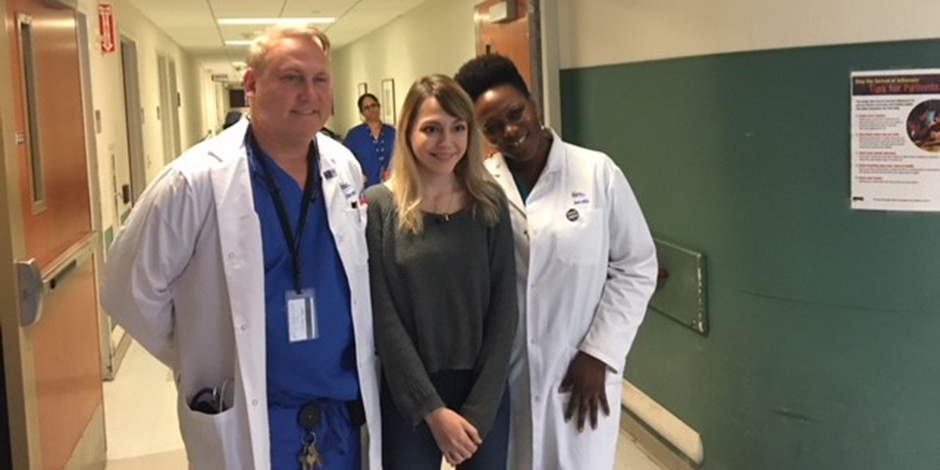NYC Health + Hospitals/Jacobi Helps Revive Victim of Car Crash
The Bronx's Level I Trauma Center Saves Patient from Severe Internal Injuries
Jan 31, 2018

A young woman who suffered life-threatening traumatic bleeding from a car crash in August, and who has made a remarkable recovery at NYC Health + Hospitals/Jacobi, is returning to continue her studies, marking an important milestone. While her odds of surviving the initial severe laceration of the retrohepatic vena cava vein were long, Viktoria Pavic now has a new lease on life.
A summer evening in late August found 21-year-old Viktoria Pavic returning to New York from an extended vacation. The college student from Dutchess County was looking forward to returning to school there for her fall semester. But heading north on the Hutchinson River Parkway in the Bronx, her car crashed, leaving her severely injured. Emergency responders rushed her to NYC Health + Hospitals/Jacobi, the Bronx and Southern Westchester’s Level I Trauma Center.
Upon arrival, Trauma Medical Director Dr. Sheldon Teperman and Vascular Surgeon Dr. Aksim Rivera assessed Ms. Pavic’s condition. “When Viktoria came to us, she was responsive but definitely hypotensive and looked gravely ill,” said Dr. Teperman. “It wasn’t until we examined her that we realized how severe her injuries were.”
Ms. Pavic was bleeding internally from the retrohepatic vena cava, a large vein that runs behind the liver and is also located only a few centimeters from the heart. Surgical access is very difficult for those reasons, as well as obstruction by other organs. Surgeries on the retrohepatic vena cava are time-consuming, while usually an urgent need for access means there is no luxury of time. If too much time passes, patients lose so much blood that they cannot be saved.
Drs. Teperman and Rivera opened Ms. Pavic—both laparotomy and sternotomy—to address her abdominal bleeding. Most urgently, the “damage control surgery” approach focused on the repair of the retrohepatic vena cava to stem the most severe bleeding. Because the trauma takes an enormous toll on the body—the lowered blood pressure leads to loss of body heat; the buildup of acid, or acidosis; and insufficient blood clotting, or trauma-induced coagulopathy—the surgical repair work could not be done all at once. Following the successful repair of the vital vein, Ms. Pavic would recover in the intensive care unit, where she received several blood transfusions and blood-related products to circulate through her body to fortify her enough to withstand multiple reconstructive surgeries. After packing her wounds and stabilizing her over three days, Dr. Teperman, Cardiothoracic Surgeon Dr. Jody Kaban, and Trauma Surgeon Dr. Edward Chao were then able to complete the needed surgical repairs to her abdomen, chest wall, and sternum.
Ms. Pavic would remain in the intensive care unit for three weeks before she was stable enough to transfer to a regular inpatient unit for another two. During this time, she was also treated for an additional injury she had sustained, called hangman’s fracture of the neck. This injury necessitated a neck brace, which Ms. Pavic wore for several months.“Normally, patients do not survive when they suffer such extensive injuries,” said Dr. Rivera. “But Viktoria showed enormous perseverance and grace throughout her recovery.”
Now ready to return to school, Ms. Pavic reflected on her experience: “After entering the ER following the crash, I don’t remember much. But what I will always remember is how sweet and supportive the doctors and nurses were during my stay at Jacobi, and the excellent care they gave me. I still have some medical issues to deal with but thanks to the staff at Jacobi, I am alive and able to enjoy life again.”